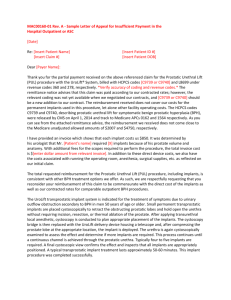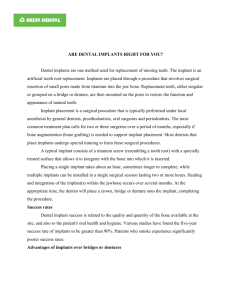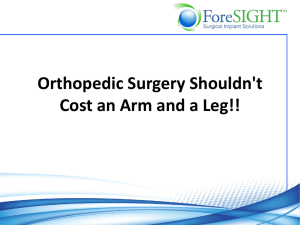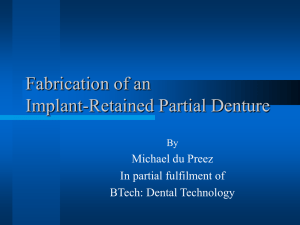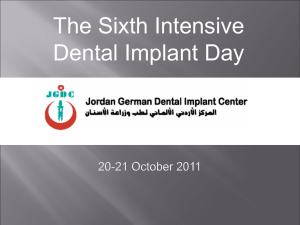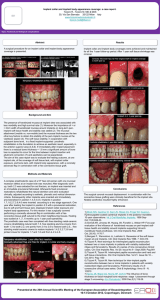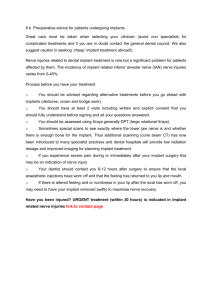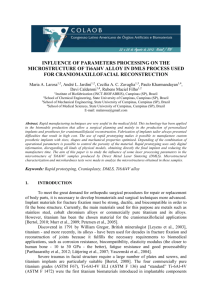Patient-Specific Implants & Anatomical Models
advertisement
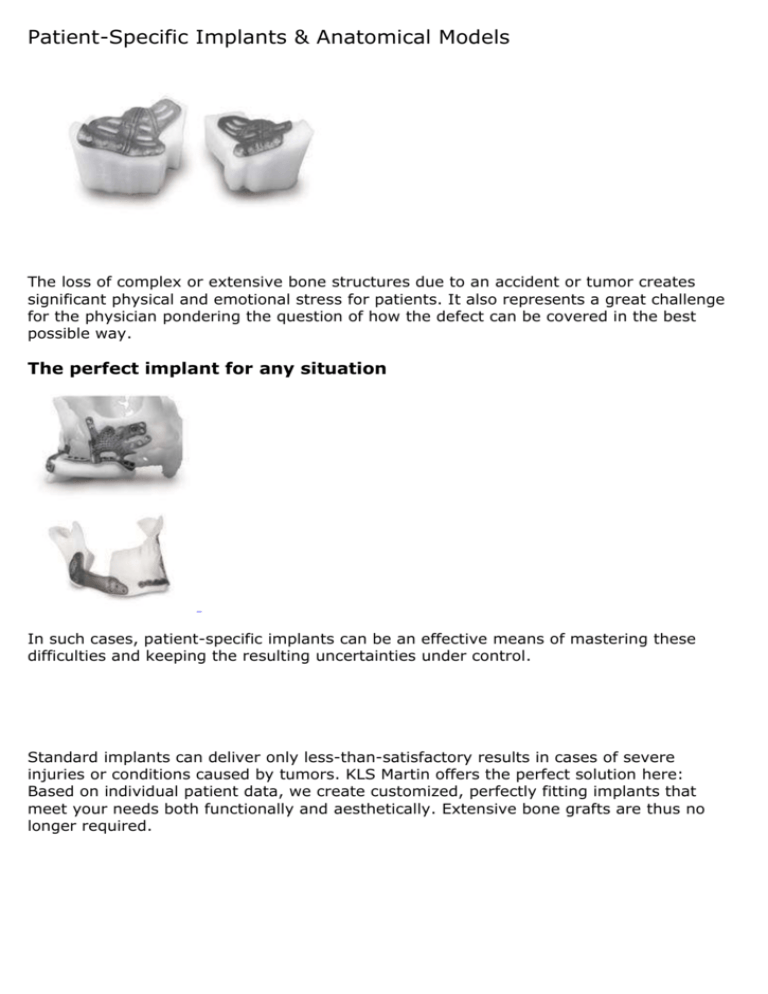
Patient-Specific Implants & Anatomical Models The loss of complex or extensive bone structures due to an accident or tumor creates significant physical and emotional stress for patients. It also represents a great challenge for the physician pondering the question of how the defect can be covered in the best possible way. The perfect implant for any situation In such cases, patient-specific implants can be an effective means of mastering these difficulties and keeping the resulting uncertainties under control. Standard implants can deliver only less-than-satisfactory results in cases of severe injuries or conditions caused by tumors. KLS Martin offers the perfect solution here: Based on individual patient data, we create customized, perfectly fitting implants that meet your needs both functionally and aesthetically. Extensive bone grafts are thus no longer required. The right material for each individual case Ti - Additive manufacturing PEEK - Polyetheretherketone Ti - Solid titanium Ti – Titanium mesh Apart from highly advanced implant materials, we offer you top-notch 3D printing technology that opens up completely new possibilities of designing your implants and their surfaces! Our comprehensive manufacturing facilities allow any type of processing. Legende: Patient-specific implants – Which base material for which purpose? AM titanium Subsequent implant correction Mechanical strength Biocompatibility Thermal conductivity Price level Osseous integration potential Volume reconstruction Artifact likelihood PEEK Titanium mesh Solid titanium Implement your own project! Our comprehensive range of services is many-faceted. Visit our dedicated webpage to learn more about our anatomical models, implants and materials. This direct access enables you to implement your own project in close collaboration with us. Step by step: from your initial request to data upload. > To learn more Additive manufacturing (AM) – Opens up completely new possibilities of implant and implant surface design! How it works Additive manufacturing refers to a 3D printing process in the field of generative manufacturing methods. Inside a high-pressure chamber, titanium powder is delivered to the working area using a doctor blade or roller. The titanium powder is then heated up by a mirror-reflected laser beam, causing the powder to melt (which is why the method is also called “laser melting”) and densifying the material as a result. Once the laser has worked over the whole surface, the working platform (table) is lowered and a new layer of titanium powder is applied on top. In this way, the workpiece is manufactured by “adding” layer after layer. Since the power density of the laser used is extremely high, it is possible to create high-density, three-dimensional objects. AM method Selective laser melting What are the resulting user benefits? Basically, the main advantages of additive manufacturing can be summarized as follows: Fast: No additional tools, jigs and fixtures are needed any more Versatile: Free design of implants and implant surfaces Osteoconductive: Implants with an open structure allow the ingrowth of endogenous cell structures Complex forms such as honeycomb, grid/lattice or porous structures are possible High-strength: The density and thus the strength of the material will be higher compared to a product made of pure titanium Comprehensive and versatile – the manufacturing technology of the KLS Martin Group Our service portfolio Complete design work Use of your datasets and joint discussion of potential problem solutions (e.g. by online meeting) without any obligation on your part Three-dimensional virtual representation of the defect reconstruction solution Conventional manufacturing techniques (milling, turning, deep-drawing, machining, etc.) Resorbable materials (using cleanroom technology) Anatomical models Generative manufacturing methods (laser melting and laser sintering) Quality assurance and validated processes Advice by qualified sales persons without any obligation on your part Indications Posttraumatic reconstructions Loss of osseous integrity Head injuries with increase of intracranial pressure Tumors, ulcers, cysts Infections or rejection responses following cranioplasty Limited supply of autogenous bone grafts Additive manufacturing offers hospitals and physicians completely new possibilities for creating patient-specific and therefore perfectly fitting implants in a very short time. The treatment of orbital floor fractures, in which the KLS Martin Group is capable of delivering the required implant within five to ten workdays, based on close collaboration with customers, is just an example. Such short time frames were previously impossible, due to the complexity of conventional process chains, not to speak of the superior quality of accurately fitting implants and the planning safety assured by this new method. Our generatively or “additively” manufactured implants close this gap, thanks to a fully CAD-based design process directly followed by an integrated manufacturing process. Important design features such as rounded, atraumatic edges can be additionally implemented as you go, and the same applies to the insertion vector or a measuring scale. In this way, the implant is designed and manufactured according to the needs and requirements of the indication so accurately that it almost falls into place when used. Deviations from preoperative planning, malposition or interference with surrounding tissues are therefore not to be expected. Additional advantages of the implant include its high rigidity and load-bearing capacity. And it won’t bounce either. Arrangement of various defects Before and during the operation No need for autologous bone grafts, no second surgical site for harvesting Significantly shortened operating times Lower rate of complications Minimally invasive – high-precision intervention that preserves surrounding tissue structures After the operation Perfect mechanical protection for the brain Low risk of rejection responses Faster rehabilitation Original appearance restored Improved quality of life For the public health system Solution for previously untreated or insufficiently treated patients Significantly shortened operating times Lower rate of complications Shorter hospitalization Lower overall treatment costs Faster rehabilitation Integrated case planning Complex reconstruction cases traditionally involve a great number of variables that are hard to control. UNIQOS utilizes the significant technical progress made in recent years in the field of EDP-based preoperative planning, integrating these concepts and objectives into an overall package that allows you to master even critical surgical situations. From anatomical models and resection and positioning templates all the way to optimized implants exactly adapted to individual patient requirements – the surgical team can now use all the tools needed for successfully implementing the preplanned results. Case example By way of example, we’d like to describe here a case of mandibular reconstruction using a fibula graft. First of all, the resection limits are determined in a joint coordination process. According to the decision of the team of treating physicians, the defect is to be reconstructed with a fibular graft from the right leg. As agreed, the right fibula is examined to locate the best possible matching graft. A resection template is created, taking anatomical aspects into account. The donor site is virtually projected to the recipient site and the graft ... ... is then optimized for best possible aesthetic results and prosthetic fit. Finally, an implant specifically optimized for the given case is generated. The entire service package at a glance. To perform the resection as planned, resection templates are needed that also reflect the cutting angle. The final step involves defining the type, diameter and length of the osteosynthesis screws to be used.


